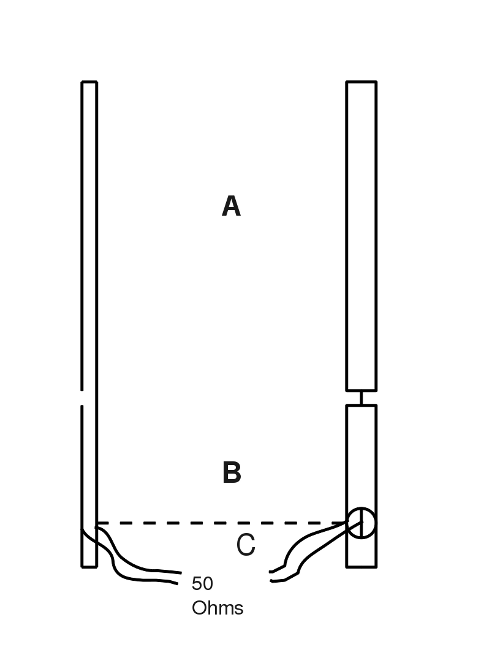This is my forum for telling the world
what's
keeping me busy these days.

Two examples of practical j-pole antennas made from antenna feedline
wire
The antenna on the left is made from 300 ohm
television twin-lead wire, and the one on the right is made of the
direct-burial 75 ohm coaxial cable. On the twin-lead antenna, dimension
A (the half wave) is 204 inches (518 cm.), B (the quarter wave) is 86
inches (218 cm.), and C, the feed attachment point, is 10 inches (25
cm.) from the shorted end. On the coax antenna, A is 178 inches (452
cm.), B is 84 inches (213 cm.), and C is 18 inches (46 cm.). Your
mileage may vary. The antenna is tuned by the following procedure:
1. Starting with a length of feedline about 10% longer than the quarter wave, connect a noise bridge and a general coverage receiver to the end of the wire that will be shorted. With the resistance in the bridge set to minimum, and the capacitance zeroed, tune the radio for minimum noise. Then trim the "far" end of the quarter wave for minimum noise at the frequency you want for the center of coverage.
2. Short the "near" end of the wire. Tap the wire approximately 10 inches (25 cm.) from the short. Connect the output connection of an SWR bridge to the tap. Add about 10% to the length of the half wave and attach it to one side of the "far" end of the quarter wave section, or to the center wire if the matching section is coax. Hang the assembly from a tree branch or other non-metallic support high enough to allow the assembly to hang straight. Trim the half wave for minimum SWR at the center of the range you want to use. Then move the tap for minimum SWR.
I used a Palomar RX Noise Bridge for tuning the length of the quarter wave. Since this is no longer being manufactured, you may wish to build your own, or obtain an MFJ or VK3AQZ one. If you Google the term "rx noise bridge pdf" you will end up with the schematics of several bridges.
1. Starting with a length of feedline about 10% longer than the quarter wave, connect a noise bridge and a general coverage receiver to the end of the wire that will be shorted. With the resistance in the bridge set to minimum, and the capacitance zeroed, tune the radio for minimum noise. Then trim the "far" end of the quarter wave for minimum noise at the frequency you want for the center of coverage.
2. Short the "near" end of the wire. Tap the wire approximately 10 inches (25 cm.) from the short. Connect the output connection of an SWR bridge to the tap. Add about 10% to the length of the half wave and attach it to one side of the "far" end of the quarter wave section, or to the center wire if the matching section is coax. Hang the assembly from a tree branch or other non-metallic support high enough to allow the assembly to hang straight. Trim the half wave for minimum SWR at the center of the range you want to use. Then move the tap for minimum SWR.
I used a Palomar RX Noise Bridge for tuning the length of the quarter wave. Since this is no longer being manufactured, you may wish to build your own, or obtain an MFJ or VK3AQZ one. If you Google the term "rx noise bridge pdf" you will end up with the schematics of several bridges.
| Previous
page |
Next page |
Questions?
Comments? Email me - jim (at) jimdaldry.com